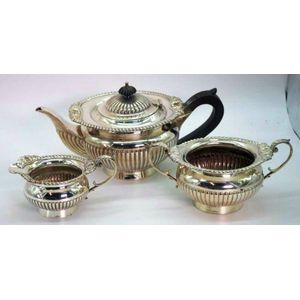Georgian Style Sterling Silver Tea Set, London 1919
A three Pcs sterling silver tea set, London 1919, by Charles Boyton & Son, comprising of teapot, sugar bowl and milk jug in the Georgian style with gadrooned decoration length 27.5 cm (teapot), total weight 1061grams
You must be a subscriber, and be logged in to view price and dealer details.
Subscribe Now to view actual auction price for this item
When you subscribe, you have the option of setting the currency in which to display prices to $Au, $US, $NZ or Stg.
This item has been sold, and the description, image and price are for reference purposes only.
- Sterling Silver - Sterling silver is a mixture of 92.5% pure silver and 7.5% of another metal, usually copper. Fine silver is 99.9% pure silver, and is relatively soft and the addition of the very small amount of copper gives the metal enough strength and hardness to be worked into jewellery, decorative and household objects.
- Gadrooning - A series of lobes usually as a border. In furniture gadrooning is found as carved decoration around the edges of table tops in the Chippendale and Jacobean style furniture. Gadrooning is also found as decoration on the rims of silver and ceramics.
- Georgian - As an English stylistic period, Georgian is usually taken to cover the period from George I (1714) to the Regency of Prince George (1811-20), although the period from 1800 to 1830 is sometimes designated as the Regency period. During the Georgian period the great English cabinetmakers and designers such as Chippendale, Hepplewhite, Adam Sheraton etc., were all active.
Therefore there isn't a single 'Georgian style' as such and to say something is 'Georgian', usually means it was made between 1714 and 1830. This assumes we discount George V and George VI, both being from the 20th century.
The styles popular at the time of each reign were:
George I (1714-1727) saw out the last years of the Baroque period.
George II (1727-1760) reigned during the Rococo period.
George III (1760-1820) saw the last gasp of the Rococo, all of the early Neo-Classic 'Adam style' and most of the later neo-Classic 'Regency style'.
George IV (Prince Regent 1820-1830)encompassed the last of the 'Regency' style.
William IV's reign (1830-1837) was something of a no man's land (stylistically) and he wasn't a 'George' anyway. He covered the last glimmerings of 'Regency' and the start of the 'Victorian' style.
This item has been included into following indexes:
- tea sets/services
Visually similar items

Hardy Bros Ltd three piece silver plate tea set, comprising of teapot, sugar and creamer
Sold by
in
for
You can display prices in $Au, $US, $NZ or Stg.

Antique sterling silver tea pot London 1906
Sold by
in
for
You can display prices in $Au, $US, $NZ or Stg.

Sterling silver small teapot & matching cream jug
Sold by
in
for
You can display prices in $Au, $US, $NZ or Stg.

George III sterling silver mustard pot & spoon, including mustard pot, London 1819, makers George Knight, with blue glass inner, & mustard spoon, London 1800, maker Richard Crossley. width 230grams, (total).
Sold by
in
for
You can display prices in $Au, $US, $NZ or Stg.
